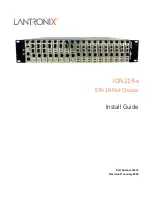
© National Instruments
|
4-11
DO Sample Clock Signal
The DO Sample Clock (do/SampleClock) signals when all the digital output channels in the task
update. DO Sample Clock can be generated from external or internal sources as shown in
Figure 4-4.
Figure 4-4.
Digital Output Timing Options
Routing DO Sample Clock to an Output Terminal
You can route DO Sample Clock to any output PFI terminal. DO Sample Clock is active high
by default.
DO Sample Clock Timebase Signal
The DO Sample Clock Timebase (do/SampleClockTimebase) signal is divided down to provide
a source for DO Sample Clock. DO Sample Clock Timebase can be generated from external or
internal sources, and is not available as an output from the chassis.
DO Start Trigger Signal
Use the DO Start Trigger (do/StartTrigger) signal to initiate a waveform generation. If you do
not use triggers, you can begin a generation with a software command. If you are using an
internal sample clock, you can specify a delay from the start trigger to the first sample. For more
information, refer to the
NI-DAQmx Help
.
Using a Digital Source
To use DO Start Trigger, specify a source and a rising or falling edge. The source can be one of
the following signals:
•
A pulse initiated by host software
•
Any PFI terminal
•
AI Reference Trigger
•
AI Start Trigger
The source also can be one of several internal signals on the cDAQ chassis. Refer to the
Device
Routing in MAX
topic in the
NI-DAQmx Help
or the
LabVIEW Help
for more information.
Programmable
Clock
Divider
DO Sample Clock
Timebase
PFI
Analog Comparison Event
Ctr
n Internal Output
DO Sample Clock
Analog Comparison
Event
20 MHz Timebase
80 MHz Timebase
PFI
100 kHz Timebase











































